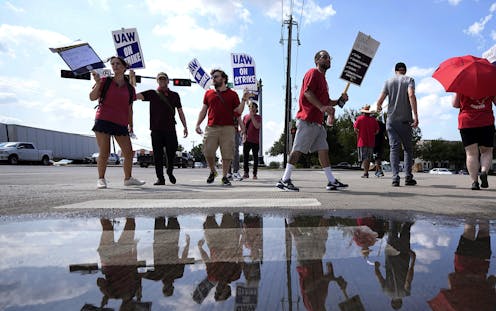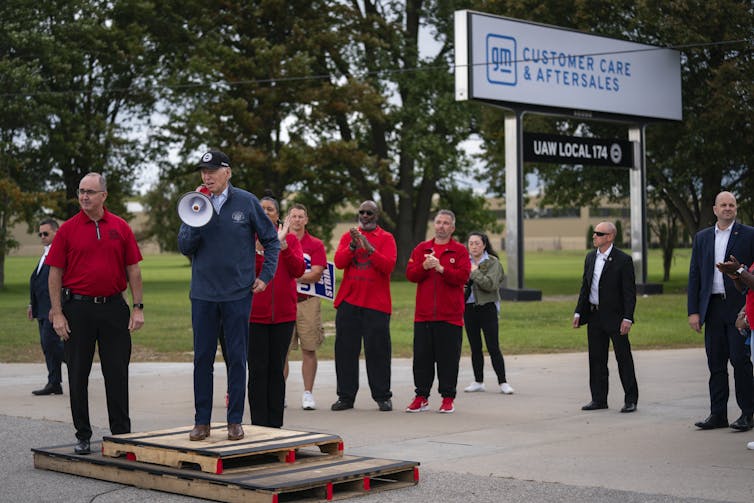Why the UAW union's tough bargaining strategy is working
The companies are making more generous offers, and the union is commanding support from the general public and the president of the United States.

The United Auto Workers union isn’t backing down as it bargains for more compensation and better benefits in its new contracts with General Motors, Ford and Stellantis. Under the deft leadership of its president, Shawn Fain, and other officials elected in March 2023, the union has thrown the three companies off balance with a strike that began on Sept. 15 – the minute its prior contracts expired.
By Sept. 29, the number of UAW members on strike from their Big Three jobs had gradually climbed to 25,000 – meaning that 1 in 6 of the union’s nearly 150,000 autoworkers was on the picket lines instead of going to work.
I’m a labor and business scholar who has studied the history of UAW collective bargaining with the Detroit Three. I’ve observed that the union’s bargaining strategy has three interconnected elements that match what Harvard Program on Negotiations researchers recommend: an emphasis on substance, processes affecting interpersonal relations, and the setup – or context.
3-part strategy
Fain and his leadership team have gotten the upper hand in all three regards.
First, it framed the negotiations by publicizing its members’ demands at the very beginning of formal talks. From the start, the union has clearly argued that the automakers’ “record profits” in recent years meant that autoworkers deserve what it calls “record contracts” to compensate them for past sacrifices, such as lowering pay and reducing benefits for newer hires.
So far, it looks like the UAW is making real gains on the substance of its demands. For example, by Oct. 3, Ford was offering a 26% pay raise, up from about 15% before the strike, and the restoration of annual cost-of-living adjustments to keep up with inflation.
Second, the union unilaterally changed the bargaining process, starting with its optics. The UAW dispensed with the traditional handshake ceremonies it had previously held with auto executives to kick off contract negotiations. “There is no point in having some pomp and circumstance and some big ceremony acting like we’re working together when we’re not,” Fain told reporters in mid-July.
Instead of participating in conciliatory photo-ops, the leadership held meet-and-greets with rank-and-file UAW members at factories belonging to Ford, General Motors and Stellantis – the global automaker that makes Chrysler, Dodge and Ram vehicles – where Fain declared that the union was ready to go on strike.
More significantly in terms of its processes, the UAW is on strike for the first time against all three of the automakers, having abandoned its prior practice of targeting one company at a time. Bargaining simultaneously with all three companies effectively pits them against each other.
One way Fain is doing that is by expanding picket lines in accordance with the progress or lack thereof each of the three automakers makes in meeting the UAW’s demands. Pressure on the companies is building with rolling deadlines at which additional strike sites are announced.
This strategy, at least in September, has led the companies to make concessions, with the union barely having to reciprocate. Although the UAW is now seeking a 36% increase in pay, down from 46%, it has not ratcheted down many of its other demands.
Third, the union has successfully used social media to get its narrative across and to rally public support for its fight with the automakers.
Perhaps the best evidence that the union’s outreach strategy is succeeding is that Joe Biden became the first sitting president to join strikers on a picket line when he made a trip to Belleville, Michigan, on Sept. 26. Once there, Biden expressed support for the UAW’s cause.
The UAW has repeatedly accused the companies of being greedy, often by pointing to what their top executives make: The CEOs of Ford, General Motors and Stellantis each received between $21 million and $29 million in compensation in 2022.
Collaborative vs. adversarial
Research on labor-management negotiations has underscored two basic approaches to bargaining: collaborative and adversarial.
Early on, collective bargaining in the U.S. auto industry was the latter.
By the late 1970s, as the Big Three lost market share to foreign automakers, the UAW was forced into a concessionary bargaining mode. It compromised on pay and benefits to enable manufacturers to compete against nonunion employers – especially in 2007 and 2009 amid weak demand for new vehicles.
In 2023, the UAW has declared those days over.
The union is instead focused on what Walter Reuther, the UAW’s longtime leader, called “the sharing of economic abundance.”
To implement its new strategy, the union is relying on several hard-bargaining tactics: extreme demands, personal attacks, threats and warnings, rolling deadlines and holding unpredictable strikes that are the same for all three companies.
Fain himself described the union’s initial demands as “audacious.”
On top of a roughly 46% wage increase, it sought the restoration of annual cost-of-living adjustments, retiree health care and defined-benefit pensions, the elimination of separate wage tiers for longtime and newer workers and increases in profit-sharing. The UAW also sought a 32-hour work week with pay for 40 hours of labor and the restoration of jobs banks – an abolished system that paid workers at closed factories who did community service.
Some analysts have estimated that accepting all of these conditions would more than double labor costs for the three automakers.

Signs of success
I think it’s clear that the union caught the companies flat-footed in response to this unconventional approach and that the Big Three are making significant concessions in terms of raising pay for the lowest-paid workers.
At the same time, gaps do remain between the union’s demands and what the companies are offering, especially in terms of across-the-board pay increases.
For example, the Big Three are still resisting the UAW’s demand that all workers at their electric vehicle and EV parts facilities have the same working conditions and compensation as those who are making vehicles with internal combustion engines and transmissions. Nor does there seem to be any progress toward shortening the work week to four days from five – which may have been more of an optimistic ask than a hard demand.
But with a little give-and-take, I have little doubt that the parties will resolve these matters. And despite this high-stakes dispute, I believe it’s possible for the automakers to wind up with a win if they can accentuate the common interests that bind labor and management to their shared future success.
While director of the Douglas A. Fraser Center for Workplace Issues at Wayne State University from 2009 through 2019, the Center received grants from the Detroit Three's joint training centers with the United Auto Workers to pursue education and research on unions and labor-management relations. These grants were operating strictly with the purview of the university.
Read These Next
The Bible says little about Jesus’ childhood – but that didn’t stop medieval Christians from enjoyin
Legends about Jesus’ early years that circulated in medieval Europe often drew on apocryphal texts.
Can scientists detect life without knowing what it looks like? Research using machine learning offer
A new machine learning model explores the boundary between biological and nonbiological chemistry.
How a niche Catholic approach to infertility treatment became a new talking point for MAHA conservat
Mainstream medical organizations have criticized ‘restorative reproductive medicine,’ but some Catholics…






